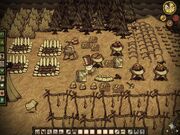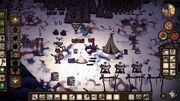| This article may contain instructional language and subjective recommendations. Readers should read the content carefully, and follow accordingly. |
Finding A Camp And Building It
Pre-camp exploration is key to knowing where to go to get different resources and where to set up camp. It is a good idea to set camp on the corner of as many Biomes as possible. This will make the finding and getting of materials and different foods easier than being in the centre of a Biome. Also, it will be very convenient to make camp near Beefalos or Pigs for Manure. This will make food creation easy and will mean that the player will need to worry less about starving. You may want to focus more on beefalo considering pigmen can be relocated later.
For long-term survival, the key part of camp location is considering resource pools that cannot be relocated. Examples of such resources are Reeds, rabbit holes, Pig King and beefalo. Location of boulders should also be considered although it gets less important as all boulders are mined out. Sometimes one or two of non-relocatable resource can be far away from base camp. In that case, an outpost should be made near that location that can be used during resource trips.
However, Forest, Swamp, and Rockyland Biomes are notably difficult to set a base in.
- The vast number of Trees in the Forest can cause an obstruction that the player must chop down. This can be resourceful, but highly irritating. If you create a basic Campfire close to a tree, the fire will spread rapidly and clear a large area for you. You can also light trees with a torch. Chopping the Burnt Trees yields Charcoal for a Crock Pot or Drying Rack.
- The Rockyland Biome's stone ground means that the planting of Berry Bushes, Saplings, Trees and Grass Tufts is impossible. The player may want to make camp just off the edge of this biome, for easy access to Boulders and for farming capability.
- Swamps are to be avoided for camps in early game, due to the occurrence of Tentacles, Merms and Mosquitoes. Do not camp here, unless you have great preparation or it is necessary. However, making a camp next to a swamp is beneficial for quicker access to Reeds.
The player should choose wisely before setting a Fire Pit, Science Machine or other utilities of this nature, for they are hard and counter productive to remove once placed.
- Camps are usually circular, centered around a Camp Fire or Fire Pit. This makes it possible to use all your utilities and Farms without having to stray into the dark at night time.
Base Camp Set-up Guide
If a location has been chosen near an Ocean, place the fire pit just inland from the ocean to give yourself room for important items.

Example of Base Camp
- Placing your camp close to a road will help to make travel and exploration much faster.
- Place the research machine (Science Machine, Alchemy Engine or Shadow Manipulator) inland, preferably near the Fire Pit. Science stations aren't often used, so it's a good idea to place them on the edge of the camp, but in range of the Fire Pit.
- Collect Berry Bushes and plant them near some Tooth Traps or Walls so that players can trap and kill Gobblers easily.
- Next, gather Grass Tufts, Saplings and Pine Cones and make Farms of each in an area near the Fire Pit.
- Hunt for Meat or Morsels until you have enough food to last a long time. (at this stage, a Crock Pot is a good idea.)
- Wall yourself up to survive incoming hound attacks and your camp will be like a fort.
- If a sinkhole is near your camp remember to make a camp there too! To camp underground go to the Guides/camping underground
- Make a Lightning Rod to keep lightning from setting fire to your base. You may need additional rods to cover your whole base.
- Spread out farms of Saplings, Grass, Berry Bushes, and trees in lines of 10. With this method, if one line is set fire, it does not burn your whole farm.
Self Sustaining food
Before winter comes you may want to set up a food source that will last. While farms and traps are good to stockpile, there are ways to collect food passively.
1. If you've settled near, or built a Pigman village at your base, a good idea is to place a spider nest close to the pig houses. This will make a perpetual monster meat or meat farm (depending on which side is winning). Although inedible, monster meat can be cooked and fed to a bird in a birdcage. The bird will drop an egg which can be a great source of food. NOTE- make sure to have enough pig houses because as the spider nest grows, the pigs could be overrun. You will also need to stand ready to pick up whichever meat drops, as pigs will eat monster meat and spiders will eat meat.
NOTE: You should be careful though, as a Pigman that has eaten 4 Monster Meats will transform into a Werepig (will transform back into a normal Pig after 4 game hours).
Biomes
![]() Main article: Biomes
Main article: Biomes

If all goes well, this is how your base camp could look like come winter!
Forest: The only truly sustainable forms of Meat/Morsels will be Pigs, and occasionally Redbirds/Crows. And on occasions roaming Beefalo from nearby grasslands.
Swamp: They can have a plentiful source of Monster Meat, Fish, and Frog Legs, but are very dangerous because they house the Tentacles, Merms, Spiders (later Spider Queens) and Mosquitoes. With the aid of a Crock Pot, the foods available are an invaluable resource in replenishing hunger. If you are thinking about setting up your camp for a more challenging playthrough or just in general, the Marsh Camp Guide can help you out.
Savanna: Arguably the second best biome for food because there are Rabbits and Beefalo roaming about. Beefalo are difficult to kill but with a bit of kiting and very minimalistic materials (i.e. enough to build a spear) they can be reliable food sources. Beefalo (if you obtain a Beefalo Hat) can also serve as extra protection against hostile creatures.
Grasslands: The least threatening biome, and home to the most plentiful food source, The biome includes plenty of Grass and Saplings which are key components in building Traps. Traps set up at the mouth of a Rabbit Hole will grant a steady income of Morsels, and the traps can be utilized more than once per day with a reliable yield of approximately 10-30 Morsels per day (assuming multiple Traps are placed and harvested regularly).
Desert: Like the Swamp, this appears to many as a relatively inhospitable biome, due to the Hound Mounds that may litter the place. However, due to the abundance of Buzzards, Cacti, Tumbleweeds, Boulders and Volt Goats, this is surprisingly one of the best biomes to take shelter in the Reign Of Giants DLC. The Hounds can be farmed for their Hound's Teeth and their Monster Meat can be used to bait Buzzards for their Morsels, Drumsticks and Feathers. Tumbleweeds can provide Cut Grass and Twigs all year round as well as contain other rare treasures if the player is lucky. The Boulders will provide the player with much needed minerals, though the Nitre and Gold containing Boulders are only situated near Hound Mounds. The Cacti are a good source of Cactus Flesh and during Summer, Cactus Flowers, which can be used to make Floral Shirts And Flower Salads, and since Cacti are unaffected by cold during Winter, Cactus Flesh can be used in lieu of farmed Vegetables. Lastly, Volt Goats can be used to get Meat and Volt Goat Horns as well as Electric Milk when charged by lightning or Morning Stars, and since they can breed like Beefalo, they are renewable as long as the player keeps at least two of them alive.
Template:Content Main
